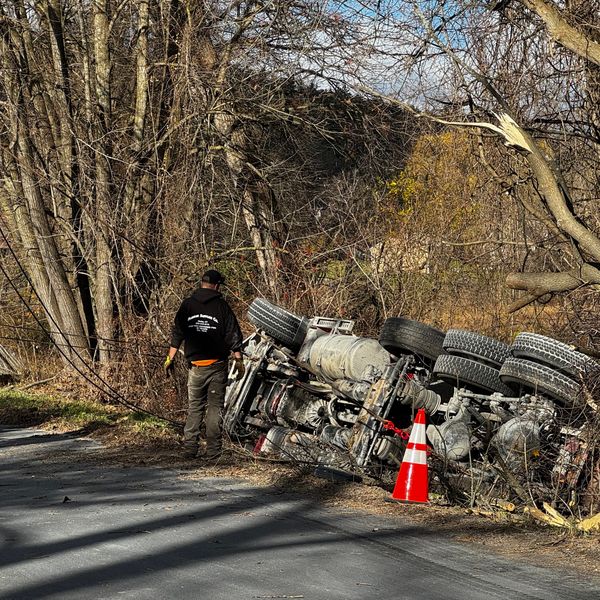Latest News
Legal Notices - November 20, 2025
Nov 19, 2025
Legal Notice
Pursuant to CT State Library, Office of Public Records, Form RC-075, regarding the disposition of public records, Housatonic Valley Regional High School, Falls Village, CT, announces plans to dispose of students’ cumulative records for the following years of graduation: 1997, 1998, 2000-2015. Please contact the Registrar at (860)824-5123x1170 to arrange a time if you wish to pick up records prior to the disposition. A government issued photo ID will be required for verification. All forementioned records will be disposed of no earlier than Friday Dec 19, 2025.
11-13-25
11-20-25
Notice of Decision
Town of Salisbury
Inland Wetlands & Watercourses Commission
Notice is hereby given that the following action was taken by the Inland Wetlands & Watercourses Commission of the Town of Salisbury, Connecticut on October 27, 2025:
Exempt -Application IWWC-25-75 by Elaine Watson for/to “Install a dock adjacent to the ordinary high-water mark of Lake Wononscopomuc. The proposed dock will be 4 feet wide and 45 feet long projecting into the lake, The dock will be assembled offsite and floated to the property location from the Town Grove where it will be secured by steel posts anchored into the lakebed. The dock will be positioned within one foot of the shoreline to provide stable and convenient access to the water”. The property is shown on Salisbury Assessor’s map and lot 47 11 and is known as O SHARON ROAD. The owner of the property is WATSON PAUL SURV & ELAINE SURV.
Any aggrieved person may appeal this decision to the Connecticut Superior Court in accordance with the provisions of Connecticut General Statutes §22a-43(a) & §8-8.
11-13-25
11-20-25
11-27-25
Notice of Decision
Town of Salisbury
Inland Wetlands & Watercourses Commission
Notice is hereby given that the following action was taken by the Inland Wetlands & Watercourses Commission of the Town of Salisbury, Connecticut on November 10, 2025:
Deemed Not Exempt - Application IWWC-25-76 by Michael Pallone requesting a declaratory ruling for a new septic system in the upland review area as maintenance of a residential property. The property is shown on Salisbury Assessor’s map 12 as lot 20 and is known as 85+85A Sugar Hill Road, Salisbury. The owner of the property is Carl Andrew Gerlach.
Any aggrieved person may appeal this decision to the Connecticut Superior Court in accordance with the provisions of Connecticut General Statutes §22a-43(a) & §8-8.
Town of Salisbury
Inland Wetlands and Watercourses Commission
Sally Spillane, Secretary
11-20-25
NOTICE TO CREDITORS
ESTATE OF WILLIAM KRUKOWSKI
Late of New York
AKA William Edward Krukowski
(25-00408)
The Hon. Jordan M. Richards, Judge of the Court of Probate, District of Litchfield Hills Probate Court, by decree dated November 6, 2025, ordered that all claims must be presented to the fiduciary at the address below. Failure to promptly present any such claim may result in the loss of rights to recover on such claim.
The fiduciary is:
Lisa Maria Inzerillo
c/o William O Riiska
William O. Riiska
3 Farnam Road
PO Box 1340
Lakeville, CT 06039
Megan M. Foley
Clerk
11-20-25
NOTICE TO CREDITORS
ESTATE OF
JEREMY ROBIN DAKIN
Late of Falls Village
(25-00381)
The Hon. Jordan M. Richards, Judge of the Court of Probate, District of Litchfield Hills Probate Court, by decree dated November 4, 2025, ordered that all claims must be presented to the fiduciary at the address below. Failure to promptly present any such claim may result in the loss of rights to recover on such claim.
The fiduciaries are:
Amanda Halle, 7 Puddlers Lane, Falls Village, CT 06031
Peter Halle, 7 Puddlers Lane, Falls Village, CT 06031
Beth L. McGuire
Chief Clerk
11-20-25
NOTICE TO CREDITORS
ESTATE OF JAMES
VAN B. DRESSER
Late of Salisbury
(25-00416)
The Hon. Jordan M. Richards, Judge of the Court of Probate, District of Litchfield Hills Probate Court, by decree dated November 4, 2025, ordered that all claims must be presented to the fiduciary at the address below. Failure to promptly present any such claim may result in the loss of rights to recover on such claim.
The fiduciary is:
Emily D Vail
Vail & Vail, LLC
5 Academy St
PO Box 568
Salisbury, CT 06068
Megan M. Foley
Clerk
11-20-25
NOTICE TO CREDITORS
ESTATE OF STEVENS HECKSCHER HARRISON
AKA Stevens H. Harrison
Late of Lakeville
(25-00415)
The Hon. Jordan M. Richards, Judge of the Court of Probate, District of Litchfield Hills Probate Court, by decree dated November 4, 2025, ordered that all claims must be presented to the fiduciary at the address below. Failure to promptly present any such claim may result in the loss of rights to recover on such claim.
The fiduciaries are:
David A, Clement
and Jay Tyron Badgley, II
c/o Linda M Patz
Drury, Patz & Citrin, LLP
7 Church Street, P.O. Box 101
Canaan, CT 06018
Beth L. McGuire
Chief Clerk
11-20-25
Salisbury Housing Committee
Annual Meeting
The Salisbury Housing Committee (SHC) is holding its annual meeting to elect officers for the coming year on Wednesday, December 3 at 5:00 pm, by Zoom. Members of the public are invited to attend this meeting and may submit nominees for the Board before the meeting. Nominations may be made to SHC, PO Box 10, Salisbury. The Zoom address will be available at salisburycthousing.org. SHC is the proprietor of affordable rental units located in Salisbury. Anyone interested in renting at any SHC location should call Tammy Broderick at 860-435-0049.
11-20-25
Keep ReadingShow less
Classifieds - November 20, 2025
Nov 19, 2025
Help Wanted
CARE GIVER NEEDED:Part Time. Sharon. 407-620-7777.
Town of Amenia is seeking applications: for Part-Time Clerk for Planning and Zoning Department. Candidates must possess high school equivalency diploma. Salary $19/hour, up to 20 hours a week. Letter of Interest may be submitted via email to dmklingner@ameniany.gov or by mail to Town Clerk, 4988 Route 22, Amenia NY 12501. Application deadline: December 4, 2025 at 2:00pm.
Town of Amenia is seeking applications: for Dog Control Officer. Candidate must possess a valid New York State driver license. Salary $10,500 annual. Experience preferred. Letter of Interest may be submitted via email to dmklingner@ameniany.gov or by mail to Town Clerk, 4988 Route 22, Amenia NY 12501. Application deadline: December 4, 2025 at 2:00pm.
Weatogue Stables has an opening: for a part time or full time team member. Experienced and reliable please! Must be available weekends. Housing a possibility for the right candidate. Contact Bobbi at 860-307-8531.
Services Offered
Deluxe Professional Housecleaning: Experience the peace of a flawlessly maintained home. For premium, detail-oriented cleaning, call Dilma Kaufman at 860-491-4622. Excellent references. Discreet, meticulous, trustworthy, and reliable. 20 years of experience cleaning high-end homes.
Hector Pacay Service: House Remodeling, Landscaping, Lawn mowing, Garden mulch, Painting, Gutters, Pruning, Stump Grinding, Chipping, Tree work, Brush removal, Fence, Patio, Carpenter/decks, Masonry. Spring and Fall Cleanup. Commercial & Residential. Fully insured. 845-636-3212.
Real Estate
PUBLISHER’S NOTICE: Equal Housing Opportunity. All real estate advertised in this newspaper is subject to the Federal Fair Housing Act of 1966 revised March 12, 1989 which makes it illegal to advertise any preference, limitation, or discrimination based on race, color religion, sex, handicap or familial status or national origin or intention to make any such preference, limitation or discrimination. All residential property advertised in the State of Connecticut General Statutes 46a-64c which prohibit the making, printing or publishing or causing to be made, printed or published any notice, statement or advertisement with respect to the sale or rental of a dwelling that indicates any preference, limitation or discrimination based on race, creed, color, national origin, ancestry, sex, marital status, age, lawful source of income, familial status, physical or mental disability or an intention to make any such preference, limitation or discrimination.
Houses For Rent
Sharon, 2 Bd/ /2bth 1900 sqft home: on private Estate-Gbg, Water, Mow/plow included. utilities addtl. Please call: 860-309-4482.
Real Estate Wanted
Retired gentleman looking: for a piece of hunting property in Lakeville. 10 acres or more. Very responsible. Safety first. Contact Bob at 203-232-9412.
Keep ReadingShow less
Lynne Killmer Stanton
Nov 19, 2025
SHARON — Lynne passed away peacefully at home on Nov. 4 after a long illness. She was born in Sharon, Connecticut, and attended Sharon Center School and HVRHS. In her junior year, Lynne transferred to Rincon High in Tucson Arizona. She made lifelong friends at HVRHS.
Lynne had many interests and talents and was known for her kindness and humor. She had a seat weaving business, was an avid gardener, loved boat rides on the lake, sold antiques and collectibles, and also hosted many fun celebrations (an annual pumpkin fiesta was a favorite) with family and friends! She started The Hills advertising magazine (a great joy in her life) where she met and made many lifelong friends.
She is survived by her husband, Bill and her sisters, Eileen and husband Ralph Coons of Tucson Arizona, Noreen and husband Tim Fahey of Huntington Vermont, and brother Ted Killmer and wife Annmarie of Divide Colorado. She leaves behind Bill’s brother Tom and sisters Sandra, Therese, and Mary and their families. She loved her many nieces and nephews, cousins, and friends’ children.
A Celebration of Life will be held in the spring. The family would like to thank The Salisbury Volunteer Ambulance Service, Lolly Schroeder for her kind and compassionate care, HVRHS friends for love and support, and friends and family for all our shared times! Contributions can be made to SVAS PO Box 582 Salisbury CT 06068-0582.
Keep ReadingShow less
Allen Young
Nov 19, 2025
SHARON — Allen Young passed away on Saturday, Nov. 8, after a long battle with Parkinson’s disease. He would have turned 85 on Nov. 14.
Academically, Allen was hard to match as he sailed through the Bronx School of Science, Yale University, and Harvard Law School. He returned to Yale in his retirement to earn a MA in history. Allen’s sport was reading history books, and he could probably tell you what Napoleon had for breakfast.
Allen spent 26 happy years at PricewaterhouseCoopers where he was Deputy General Counsel. It was in that time that he developed a love for a perfect Manhattan straight up. This remained his cocktail time favorite.
Allen was active in Sharon town politics and served on the board of The Hotchkiss Library. He served on the Zoning Board of Appeals and the Democratic Town Committee. He was also on the board of Crescendo.
Allen is remembered by his family as being joyful and deeply kind.
He is survived by his wife Lindley Young, his daughter Ridgley Sraka, his son Nate Young and stepdaughters Katherine Singer and Ann Volkwein. His grandchildren and step-grandchildren are Hazel Straka, Henry Straka, Alisa Young, Victor Young, Jackson Singer, Sloane Singer, and Maximus Saxton.
In lieu of flowers, memorial contributions may be made to The Hotchkiss Library.
The Kenny Funeral Home has care of arrangements.
Keep ReadingShow less
loading









